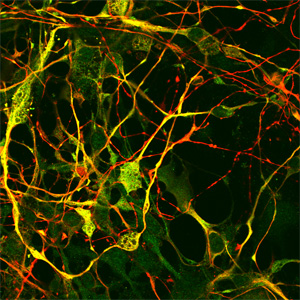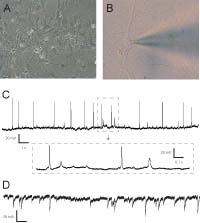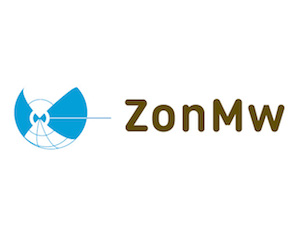
The center has established a variety of functional assays crucial to the study of neuronal communication in human neurons. These assays center around the question how neurons communicate in culture and how they transport information, in the form of chemical or electrical signals through and between the cells. The underlying postulate is that this communication is affected in the disease areas that this center studies.
 We study synaptic communication between neurons in culture using patch clamp physiology of individual cells in the culture and record action potentials propagating in the network and synaptic transmission between neurons. Using different populations of neurons we can study glutamatergic (excitatory) or GABAergic (inhibitory) neurotransmission or, by seeding mixtures of glutamatergic and GABAergic neurons, mixed excitatory and inhibitory transmission, i.e., a
We study synaptic communication between neurons in culture using patch clamp physiology of individual cells in the culture and record action potentials propagating in the network and synaptic transmission between neurons. Using different populations of neurons we can study glutamatergic (excitatory) or GABAergic (inhibitory) neurotransmission or, by seeding mixtures of glutamatergic and GABAergic neurons, mixed excitatory and inhibitory transmission, i.e., a
Fcondition that most resembles in vivo neuronal network. In addition, we can generate specific subpopulations of neurons, such as dopaminergic neurons, which comprise a minor population in the in vivo brain, to address specific questions pertaining to these subpopulations of neurons.
urthermore we study Ca2+-dynamics in neurons and synapses using Ca2+-imaging in individual neurons. Using different microscopic techniques we can either zoom in into individual nerve branches or study (synchronous) patterns of activity in networks of cultured neurons.
Relevant papers
Some highlights of the last 5 years:
- Walter et al. (2014) EMBO J. 33, p1681-97; PMID: 24902738
- Aarts et al. (2014) Nat. Neurosci. 17, p491-6; PMID: 24671065
- Cijsouw et al. (2014) J. Cell Biol. 204, p759-75; PMID: 24590174
- Li et al. (2013) Neuron 79, p970-86; PMID: 24012009
- Ripke et al. (2013) Nat. Genet. 45, p1150-9; PMID: 23974872
- Nair et al. (2013) J. Cell Biol. 200, p61-80; PMID: 23277425
- Van der Sluis et al. (2013) Mol. Psychiatry 18, p2-13; PMID: 22614290
- Heutink and Verhage (2012) Neuron 75, p935-8; PMID: 22998859.
- Van de Bospoort et al. (2012) J. Cell Biol. 199, p883-91; PMID: 23229896
- de Jong et al. (2012) J. Cell Biol. 197, p327-37; PMID: 22492722
- Meijer et al. (2012) EMBO J. 31, p2156-68; PMID: 22446389
- Mohrmann et al. (2010) Science 330, p502-5; PMID: 20847232
- Groffen et al. (2010) Science 327, p1614-8; PMID: 20150444
- de Wit et al. (2009) Cell 138, p935-46; PMID: 19716167
- Gerber et al. (2009) Science 321, p1507-10; PMID: 18703708
2025 © iPS Center. All Rights Reserved. Privacy Policy | Terms of Service

